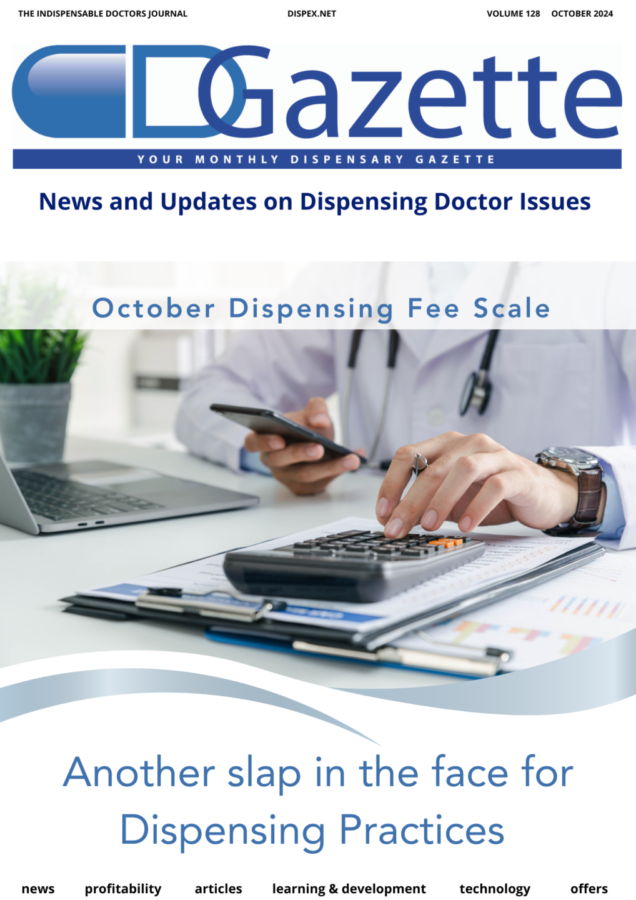Dispensing and the drive for environmental sustainability
By Dr Philip Koopowitz- Dispex & Hexagon6
Chlorofluorocarbons (CFCs) inhaler propellants contained in pMDIs (pressurised Metered Dose Inhaler)
were recognised as ozone depleting substances and were phased out in the UK by 1996. CFCs were
replaced by ‘CFC-free’ inhalers containing hydrofluorocarbons (HFCs). Although HFCs are not ozone
depleting substances, they are powerful greenhouse gases which can contribute to global warming.
Carbon emissions from inhalers have been assessed as being responsible for approximately 3% of all
NHS carbon emissions.
The Carbon footprint impact of two puffs of a salbutamol pMDI has been estimated to be equivalent
to a 500 g CO2. This compares to the carbon footprint of a 7-mile car journey which is estimated at
approximately 2000 g CO2e. In other words, a patient using a salbutamol pMDI 2 puffs, 4 times a day,
will have contributed the equivalent of a 7 mile car journey to environmental CO2 emissions. Unfortunately,
it is very difficult to assess the Cradle to Grave (CTG) CO2 emissions of different inhalers, as the data is not
readily available from most of the manufacturers. This leaves us with comparing the carbon impact of the
pMDI propellants, which make up the majority of the carbon impact of the product lifecycle.
The NICE patient decision aid gives an indicative range for DPI (Dry Powder Inhalers) and pMDIs:
·DPIs (1 dose (two puffs)): 20 g CO2e per dose
·pMDIs (two puffs): 500 g CO2e per dose
This is, unfortunately, not the full story, as some pMDIs have a higher indicative carbon footprint when
compared with other pMDIs. There is an incentive, via the PCNs, to move over to more environmentally
sustainable inhalers via the Investment and Impact Fund (IIF) 2022/23 Environmental Sustainability
Indicator which looks at 2 measures:
ES-01: Metered Dose Inhaler (MDI) prescriptions as a percentage of all non-salbutamol inhaler
prescriptions issued to patients aged 12 years or over.
ES-02: Mean carbon emissions per salbutamol inhaler prescribed (kg CO2e)
Looking at ES-02: Ventolin Evohaler has an indicative CO2e of 141 per puff, as opposed to Salamol MDI
which is 60 and Salamol Easi-Breathe is 61. Clearly it makes enviro-nmental sense to swap from Ventolin
evohaler to Salamol CFC-Free Inhaler. The most environmentally friendly Salbutamol inhaler is Ventolin
Accuhaler, with the next best being Easyhaler salbutamol. The cost differential for the NHS is 4 pence per
inhaler cheaper by changing from Ventolin to Salamol pMDI. The cost differential widens to over £5 more
expensive per inhaler when changing from Ventolin Evohaler to Easyhaler Salbutamol, and Ventolin
Accuhaler is about 50 pence more expensive than the Evohaler, although this is for 60 doses compared to
the 200 doses of the Evohaler.
Dispex has assessed the impact on profitability of all these possible changes and this information can be
accessed via the Brand Comparisons section of the Dispex website which is a Members’ only resource.
| Brand name | Device type | Doses per inhaler | NHS cost per inhaler | Indicative carbon footprint /inhaler (g CO2e) |
| Airomir 100 micrograms | pMDI | 200 | £1.97 | 48.6 |
| Airomir Autohaler 100 micrograms | pMDI | 200 | £6.02 | 48.6 |
| Easyhaler Salbutamol 100 micrograms | DPI | 200 | £3.31 | 3.10 |
| Easyhaler Salbutamol 200 micrograms | DPI | 200 | £6.63 | 3.10 |
| Salamol CFC-Free Inhaler 100 micrograms | pMDI | 200 | £1.46 | 59.75 |
| Salamol Easi-Breathe 100 micrograms | pMDI | 200 | £6.30 | 60.6 |
| Salbulin Novolizer 100 micrograms | DPI | 200 | £4.95 | 18.75 |
| Salbulin Novolizer 100 micrograms Refill | DPI | 200 | £2.75 | 18.75 |
| Ventolin Accuhaler 200 micrograms | DPI | 60 | £3.60 | 2.92 |
| Ventolin Evohaler 100 micrograms | pMDI | 200 | £1.50 | 141.31 |
Over the next few editions of the Gazette, Dispex will be looking at ES-01: Metered Dose Inhaler (MDI)
prescriptions as a percentage of all non-salbutamol inhaler prescriptions issued to patients aged 12
years or over.
We will be assessing the potential impact some of these might have on dispensary viability, alongside the
importance of the drive to ensure environmental sustainability. We will be offering choices for dispensing
practices and member practices can access the profitability impact of those choices.
Greener Practice, a Primary Care Group, has a wealth of resources to assist you in making changes to more
environmentally friendly inhalers as well as other resources which can help you make your dispensary a
beacon of sustainability. They welcome all members of primary care teams. www.greenerpractice.co.uk/

